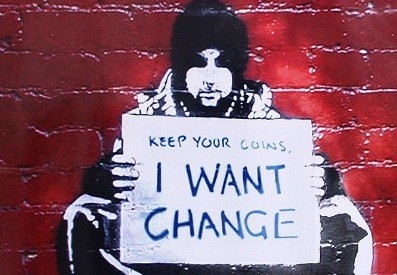 I love Banksy and his rogue artwork, such as “I Want Change” (pictured here). Like the best provocateurs, he gets us to think and opens our minds to a different point of view. In the social sector, we often have our own perspective, shaped by experience and bias, on what change is. And, we often assume our version of change is the best. But, to make the biggest impact, we need to shed our biases and focus on the greater good. In today’s guest post, Rolfe Larson of Rolfe Larson Associates, just like Banksy, challenges us to do just that by rethinking our stance on the why and how of social enterprise.
I love Banksy and his rogue artwork, such as “I Want Change” (pictured here). Like the best provocateurs, he gets us to think and opens our minds to a different point of view. In the social sector, we often have our own perspective, shaped by experience and bias, on what change is. And, we often assume our version of change is the best. But, to make the biggest impact, we need to shed our biases and focus on the greater good. In today’s guest post, Rolfe Larson of Rolfe Larson Associates, just like Banksy, challenges us to do just that by rethinking our stance on the why and how of social enterprise.
Thousands of nonprofits who use the marketplace to accomplish their social goals call themselves social enterprises (SE). Thousands of for-profit companies with social goals also use that term. Yet, these two groups barely talk with each other. Why is that?
Benefit corporations and B Corps
Even among for-profit SEs, there is a lack of kinship. Although benefit corporations and B Corps have many common characteristics, there is a stark absence of collaboration and sharing between the two. Benefit corporations, a type of for-profit legal structure, can make decisions based on impact on the community, the environment and workers – not just shareholder value. B Corps, a certification program, evaluates for-profit companies that take social responsibility seriously. B Corps undergo a rigorous assessment in areas such as governance, social and environmental impact, and employee practices.
We think these movements would benefit from working together and learning from one another. Yet, they operate as if there were a tall wall between them.
We say, Tear Down This Wall!
“True” Social Enterprises?
The wall is even higher between for-profit and nonprofit SEs. The general perception among many nonprofit social enterprise leaders is that B Corps and benefit corporations are not “true” SEs, since profit, not social impact, is not their primary purpose.
For example, Kevin Lynch, past president and of Social Enterprise Alliance, is worried that “the idea of social enterprise is now more associated with benefit corporations and B Corps than with the selfless, unsexy nonprofit social enterprise model in which impact is part of the DNA.” He added his concern that “the work of true social enterprises, that put real impact first, will be overshadowed and ignored.” (Emphasis added.)
Similarly, leaders and participants in the fast-growing B Corp movement generally assume that all nonprofits are completely dependent on grants and contributions, and are therefore ill-equipped to function in the marketplace.
What’s going on here? To get a clearer picture, we decided to crowd-source this problem online (to the npEnterprise Forum which is no longer active).
It’s About Impact
Several people pointed out that what matters is impact not structure. “We should encourage people to focus on what binds us together,” noted Hannah Pechan, “to keep our eyes on maximizing positive impact. Like most of life, it takes all kinds.”
Fernando Botelho indicated that “social problems or the damage being done to nature are indifferent to our intellectual limitations. If a small change in a large multinational prevents the dumping of 100 thousand tons of CO2, that is exactly as valuable as the same reduction being achieved by a specialized NGO dedicated entirely to that purpose.”
It’s About the People
Hildy Gottlieb argues that “it’s always about the people. When we start asking, ‘Who else cares about this?’ and begin engaging as people, we don’t have to work at the walls coming down. They come down on their own.”
Jerr Boschee took a philosophical approach to this question. “The philosopher Jacques Ellul once observed that we all get our hands dirty. The only question we should ask ourselves is just how dirty we want them to get,” Boschee observed. “I’m willing to take the risk that some private sector social enterprises run off the rails in exchange for those that can scale more quickly and do more social good than they would if they were structured as nonprofits.”
In summary, we wonder whether we should look more at the why behind the social impact that each social enterprise has, rather than how they are at achieving it.
Again, we say, Tear Down This Wall!
Rolfe and I would love your perspective on this radical idea.
